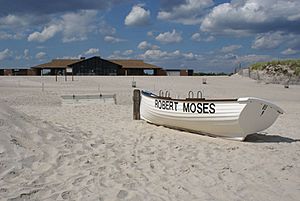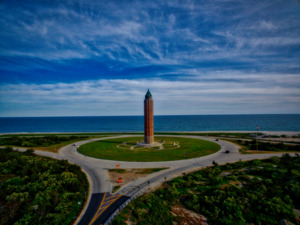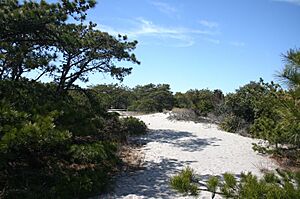Robert Moses State Park facts for kids
Quick facts for kids Robert Moses State Park |
|
|---|---|

A lifeboat on the beach at
Robert Moses State Park |
|
| Lua error in Module:Location_map at line 420: attempt to index field 'wikibase' (a nil value). | |
| Type | State park |
| Location | Fire Island, New York |
| Nearest city | Babylon, New York |
| Area | 875 acres (3.54 km2) |
| Created | 1908 |
| Operated by | New York State Office of Parks, Recreation and Historic Preservation |
| Visitors | 3,477,086 (in 2014) |
| Open | All year |
| Website | Robert Moses State Park |
Robert Moses State Park - Long Island is a large state park in Suffolk County, New York. It covers about 875 acres (354 hectares). This park is located on the western end of Fire Island, which is a long, narrow island off the southern coast of Long Island. The park is well-known for its 5 miles (8.0 km) of sandy beaches along the Atlantic Ocean. You can reach the park from Long Island by driving over the Robert Moses Causeway bridge, which crosses Great South Bay.
The park first opened in 1908 as Fire Island State Park. It is the oldest state park on Long Island. Later, its name was changed to honor Robert Moses. He was an important city planner in the mid-1900s. He also used to be the head of the Long Island State Park Commission. Some people today think the park should go back to its old name or a name that better shows where it is.
Contents
What Can You Do at Robert Moses State Park?
Robert Moses State Park offers 5 miles (8.0 km) of beach for visitors. You can enjoy swimming, surfing, or fishing here. People who like to fish can cast their lines from the beach or from the piers. There is also a special boat basin where up to 40 boats can dock for the day.
The park has four bathhouses where you can change and shower. You'll also find four snack stands, one at each main parking area. There are volleyball courts for games, first aid stations for safety, and picnic areas for outdoor meals. Kids can have fun at the playground located at Field 5.
Can You Play Golf at the Park?
On the west side of the park, there is an 18-hole golf course. It's a "pitch and putt" course, which means it's shorter and easier than a regular golf course. This quiet course is surrounded by native trees and beach plants. It is usually open from April to November. You can even rent golf equipment if you don't have your own.
Visiting the Fire Island Lighthouse
Robert Moses State Park also helps people get to the Fire Island National Seashore. This protected area is right next to the park on its east side. Since there's no parking directly at the Seashore, many visitors park at Field 5 in Robert Moses State Park. From there, they can walk to Lighthouse Beach, the Fire Island Lighthouse and Museum, or the nearby town of Kismet. In 2010, officials said that about 30% of people who parked at Field 5 did so to visit the Lighthouse.
How to Get There and When Is It Open?
You can drive to the park using the Robert Moses Causeway. This bridge connects Fire Island to mainland Long Island. There are four separate parking areas. Parking fields 2, 4, and 5 can hold about 1,000 cars each. Field 3 can hold about 500 cars. A bus route, the S47 from Suffolk County Transit, also goes to the beach during certain seasons. It connects the park with the Babylon train station.
The park is open all year, from sunrise to sunset. However, the hours for activities like swimming and golfing might change depending on the season. Some parts of the park are open 24 hours a day for fishermen who have a special permit.
There is a fee to park your car at the park, usually starting in early April. The fees change throughout the year and are higher on weekends and holidays during the summer.
History of Robert Moses State Park

The western part of Fire Island was once owned by William "Tangier" Smith. In 1825, the government bought the very tip of the island to build a lighthouse. Later, in 1855, David Sammis bought about 120 acres (49 ha) to the east and built a hotel called the Surf Hotel.
In 1892, there was a fear of a sickness called cholera spreading from ships arriving in New York. Because of this, the state bought the hotel property to set up a quarantine station. This was a place where people arriving on ships could be checked for sickness.
In 1908, Governor Charles Evans Hughes signed a law that made the former Surf Hotel property Long Island's first state park. It was called Fire Island State Park back then. The island and the park have actually grown bigger since that time. For many years, sand has been building up along the western tip of Fire Island. This has made the island about 5 miles (8.0 km) longer since 1825. When the park first started, the western tip of the island was near where the park's water tower stands today.
A fire in 1918 destroyed the boardwalk and the few buildings at the park. In 1924, the state created the Long Island State Park Commission. Robert Moses was put in charge of this commission. The commission got 4 miles (6.4 km) of beach west of the lighthouse from the government. This beach had formed because of shifting sand. In 1926, the first bathhouse was built.
After a big storm in 1938, the park was badly damaged. The commission decided to rebuild it farther east, closer to the lighthouse. They also pumped sand onto the beach to make part of the island 18 feet (5.5 m) higher than sea level. In 1940, a new, modern bathhouse opened to the public. It replaced the buildings that the storm had destroyed.
Before 1964, people used to take a ferry from Babylon to get to the park. But in 1964, the Robert Moses Causeway bridge opened, making it much easier to drive there. The park was renamed after Robert Moses that same year. More and more people started visiting. Three new parking areas with bathhouses were added to handle all the visitors.
Robert Moses State Park celebrated its 100th birthday on June 27, 2008. This special day also marked the completion of several improvements at the park. For example, the bathhouse at Field 3 was updated. This project improved the bathrooms and fixed the park's clock tower. It also replaced a modern glass front with a new look that matched the building's original design. These updates were part of a larger plan to improve New York's state parks.
In 2013, a big project helped fix the beaches that were damaged by Hurricane Sandy. This project used a lot of sand (about 520,000 cubic yards or 400,000 cubic meters) that was removed from a boat canal. This sand was then used to rebuild the beaches at Robert Moses State Park.
In 2015, a plan was announced to make the park more energy-efficient. This included installing a large solar power system that could produce 500 kilowatts of electricity. The goal was to make Robert Moses State Park the first state park in the United States that produces all the energy it needs.
As of 2014, about 3.5 million people visit the park each year.




